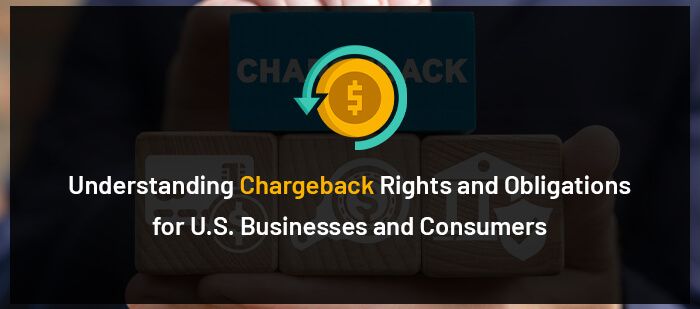
Navigating the complexities of chargebacks is essential for both U.S. businesses and consumers alike. Chargeback rights are designed to protect consumers from fraudulent transactions and ensure that they can reclaim funds when necessary.
However, these rights also impose specific obligations on businesses, requiring them to understand the U.S. chargeback process thoroughly to minimize disputes and potential financial losses. As online shopping continues to grow, awareness of how chargebacks work becomes increasingly critical.
Businesses must implement effective strategies to handle chargeback requests, while consumers need to be informed about their rights and the steps involved in initiating a chargeback. This blog post will delve into the nuances of chargeback rights and obligations, providing valuable insights to help both parties navigate this crucial aspect of financial transactions.
Introduction to Chargebacks and Their Importance
Chargebacks serve as a critical mechanism in the financial landscape, allowing consumers to dispute unauthorized or erroneous transactions. Originating from credit card transactions, a chargeback reverses a payment and credits it back to the consumer’s account, pending investigation.
This system acts as a safeguard for consumers, ensuring that they are not unfairly charged for products or services that were not received, were defective, or were misrepresented. The chargeback process is essential not only for consumer protection but also for maintaining trust in the payment system, particularly in the realm of e-commerce where face-to-face transactions are not possible.
For businesses, understanding the intricacies of chargebacks is vital to managing potential disputes effectively. Failure to address chargebacks appropriately can result in financial losses and damage to a business’s reputation. Moreover, high chargeback rates can lead to increased processing fees or even the termination of merchant accounts. By comprehending the importance of chargebacks, both consumers and businesses can better navigate and mitigate the risks associated with financial transactions.
Some Related Blogs
- The Financial Impact of Chargebacks: How U.S. Companies Can Save with Strategic Solutions
- Top Chargeback Management Solutions for U.S. Merchants in 2024
- How Payment Authentication Mitigates Chargeback Risks
- How U.S. Enterprises Can Combat Chargeback Fraud with Advanced Payment Technologies
The U.S. Chargeback Process Explained
The U.S. chargeback process involves several key steps, starting with the consumer identifying a discrepancy or issue with a transaction on their credit card statement. The consumer must then contact their card issuer to dispute the charge. The issuer reviews the claim and, if deemed valid, initiates a chargeback by reversing the transaction amount and notifying the merchant’s acquiring bank. The merchant is then informed and given a chance to respond, providing evidence to refute the chargeback if they believe it to be unjustified. This evidence may include transaction records, shipping confirmations, or communication with the consumer.
Next, the acquiring bank reviews the merchant’s evidence and makes a decision to either uphold the chargeback or reject it, crediting the merchant’s account accordingly. If the chargeback is upheld, the merchant may choose to further dispute the decision through a process known as representment, where additional evidence is submitted for reconsideration. Throughout this process, strict deadlines are enforced to ensure timely resolution. Understanding these steps is crucial for both consumers and businesses to effectively manage and resolve disputes within the framework of the U.S. chargeback system.
Rights and Obligations of U.S. Consumers
U.S. consumers possess specific rights when it comes to initiating chargebacks, which are designed to protect them from unauthorized, erroneous, or fraudulent transactions. One primary right is the ability to dispute charges that appear incorrect or unauthorized on their credit card statements. To exercise this right, consumers must adhere to the timelines specified by their card issuers, typically within 60 days from the date of the statement showing the disputed charge. Failure to meet these deadlines can result in the forfeiture of the right to a chargeback.
Additionally, consumers are obligated to provide accurate and truthful information when disputing a charge. Fabricating reasons for a chargeback or misrepresenting facts can lead to penalties, including the denial of future chargeback claims and potential legal repercussions. Consumers should also maintain records of all relevant transaction details, communications, and any evidence supporting their dispute, as this information may be crucial during the investigation process.
![]()
Email us anytime!
Email customer service 24/7
![]()
Call us anytime!
Reach customer care 24/7 at +1 (888) 901-8653
It is important for consumers to first attempt to resolve the issue directly with the merchant before initiating a chargeback. Many disputes can be amicably settled through direct communication, which may save time and resources for both parties involved.
Responsibilities and Strategies for U.S. Businesses
U.S. businesses must adhere to certain responsibilities to effectively manage chargebacks and mitigate their impact. First and foremost, businesses should ensure transparent and clear communication with customers regarding their products, services, and terms of sale. This helps prevent misunderstandings that could lead to chargebacks. Additionally, businesses should implement robust fraud prevention measures, such as using advanced security protocols and monitoring transactions for suspicious activity.
Accurate record-keeping is essential, as it allows businesses to provide compelling evidence when disputing a chargeback. This includes maintaining transaction records, shipping confirmations, and communication logs. Training staff to recognize and handle potential chargeback situations can also improve response times and outcomes.
Employing automated chargeback management tools can streamline the process, helping businesses respond within the strict deadlines imposed by card networks. Proactive customer service is another critical strategy; addressing customer complaints and inquiries promptly can often resolve issues before they escalate to chargebacks.
Finally, understanding and adhering to the specific policies and requirements of different card networks can help businesses navigate the chargeback process more effectively. By adopting these strategies, U.S. businesses can reduce the incidence and impact of chargebacks, safeguarding their financial stability and reputation.


